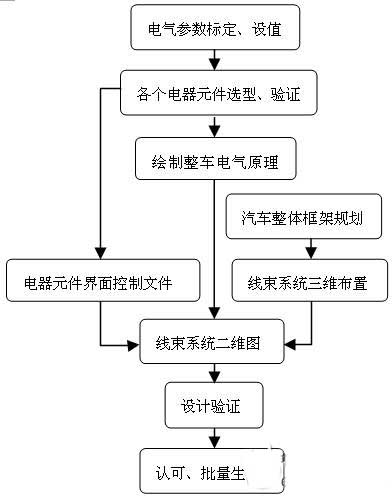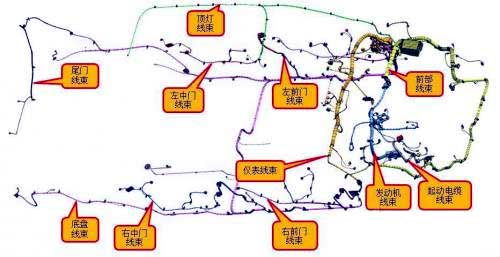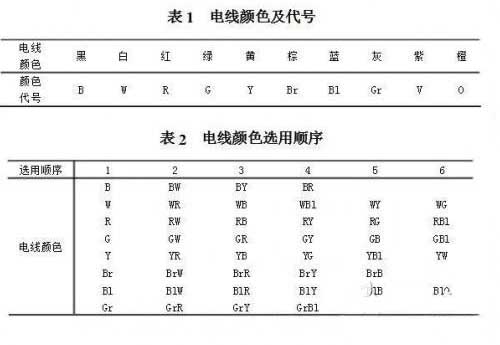Design method of automobile wiring harness system
As the nerve of the car, the wiring harness system serves as the important task of connecting the central control components and the various electrical appliances of the car. The design quality of the wiring harness system is directly related to the safety of the vehicle. With the increasing popularity of the automobile market, the rapid development of the electronic and electrical industry, the rapid increase of automotive electronics and appliances, coupled with the improvement of people's requirements for automobile safety, comfort, economy and emissions. Wiring harnesses are used more and more widely in automobiles, and the design of automotive wiring harness systems has become more important and strict.
I. Design Flow
The design of the wiring harness system is a rigorous project, paying attention to gradual progress. Figure 1 is the design process of the automotive wiring harness system.

II. Principles of layout
2.1 Early planning
In the conceptual design and structural design stages of the whole vehicle, it is necessary to integrate the overall layout awareness of the wiring harness and make a good pre-planning. The storage battery, fuse box, and central control components are best arranged in a centralized manner, which not only saves the cost of the main wiring harness, reduces the overall quality of the vehicle, improves the aesthetics of the wiring harness layout, but also greatly reduces the risk of burning the vehicle.
2.2 Modularity
The wiring harness system should be modularized according to the functions and characteristics of the whole machine, which is convenient for disassembly and assembly, easy for maintenance, and saves vehicle maintenance and repair time. Figure 2 is a three-dimensional wiring diagram of a passenger car's wiring harness system. There are 11 modules including engine wiring harness, starting cable wiring harness, front wiring harness, instrument wiring harness, top light wiring harness, left front door wiring harness, left center door wiring harness, right front door wiring harness, right center door wiring harness, tail door wiring harness, and chassis wiring harness.
2.3 Layout environment
Avoid sharp edges, high temperatures, oil passages, water pipes, and moving parts as much as possible during wiring harness layout to ensure the reliability of the layout. If it cannot be avoided, corresponding protective measures must be taken. For example, in the engine compartment, the engine wiring harness should fully consider engine vibration and heat radiation around the exhaust manifold. A fixed point must be set every 200mm, and the distance from the heat source should not be less than 100mm. A heat shield is attached before the wire harness and the heat source, and the wire harness is wrapped with a high temperature resistant corrugated tube. The door wiring harness should focus on factors such as through holes, sealing, assembly, etc., and plastic protective sleeves should be used to prevent the wiring harness from failing due to wear and tear; Try to arrange on the dry side of the door to prevent water leakage from affecting the wiring harness; Use as few buckles as possible to fix as many wiring harnesses as possible, reducing openings on the car body and assembly complexity.

2.4 Anti-electromagnetic interference
In areas with strong electromagnetic interference or sensitive signals, pay attention to adding anti-magnetic protection to the wiring harness, and set the wires to twisted pair or shielded wires, such as CAN bus. Since the internal electronic control components of the car interfere with the CAN bus, making it in the external electromagnetic environment that varies from low frequency to high frequency, higher requirements are put forward for the anti-interference ability of the CAN bus. As a CAN bus for reliable data transmission, it is particularly important to ensure its good anti-electromagnetic interference characteristics.
2.5 Design principles of grounding
Most of the failures of automobile electrical appliances are caused by ground failure, usually due to poor ground connection or broken ground wire. Therefore, the design of the grounding points of the electrical equipment in the car circuit should be reasonably arranged according to the nature and function of the electrical equipment to ensure the good working condition of the electrical equipment on the car.
2.5 Design principles of grounding
Most of the failures of automobile electrical appliances are caused by ground failure, usually due to poor ground connection or broken ground wire. Therefore, the design of the grounding points of the electrical equipment in the car circuit should be reasonably arranged according to the nature and function of the electrical equipment to ensure the good working condition of the electrical equipment on the car.
(1) The grounding points of electrical appliances that have a large impact on the performance and safety of the entire vehicle and are easily interfered by other electrical appliances must be set up separately, such as engine, ECU, ABS, etc.;
Weak signal sensors or electrical appliances that are susceptible to interference should set up separate grounding points to make the electrical circuit as short as possible to ensure the true transmission of signals: such as radio systems such as audio;
The grounding point for high-current electrical appliances should also be set up separately to ensure that the loop is grounded nearby, shorten the loop length, reduce voltage drop, and electromagnetic interference, which is safe and economical.
(2) In order to improve the reliability of key electrical equipment that affects personal safety in automobiles, double grounding, such as airbag systems, is used to ensure accurate and timely work.
(3) General electrical appliances can selectively share grounding irons according to their three-dimensional layout location and environment, reducing assembly complexity and material costs.

III. Two-dimensional wiring harness diagram design
3.1 Overview of 2D drawing design
Weak signal sensors or electrical appliances that are susceptible to interference should set up separate grounding points to make the electrical circuit as short as possible to ensure the true transmission of signals: such as radio systems such as audio;
The grounding point for high-current electrical appliances should also be set up separately to ensure that the loop is grounded nearby, shorten the loop length, reduce voltage drop, and electromagnetic interference, which is safe and economical.
(2) In order to improve the reliability of key electrical equipment that affects personal safety in automobiles, double grounding, such as airbag systems, is used to ensure accurate and timely work.
(3) General electrical appliances can selectively share grounding irons according to their three-dimensional layout location and environment, reducing assembly complexity and material costs.

III. Two-dimensional wiring harness diagram design
3.1 Overview of 2D drawing design
The wiring harness components are selected by the data parameters of the interface control files such as automotive sensors, actuators, central control components, and the automotive circuit schematic diagram, and then combined with the three-dimensional wiring diagram to complete the two-dimensional wiring harness diagram. The two-dimensional wiring harness diagram is mainly for debugging and maintenance, and should include in detail:
The fixing method, fixing position and wrapping method of the wiring harness; local special protection measures; Connector model and manufacturer; Harness part number, wiring harness version; The type, diameter, color, start and end position of each loop wire; Wire harness technical requirements, etc. Ensure that the wiring harness has enough margin to avoid putting the wiring harness under tension or tension. In view of the fact that the wiring harness is a deformable part of the automobile part, its actual length and branch position must be verified by actual vehicle measurement.
3.2 Route color and route labeling
With the increase of automobile electrical appliances, the number of wires has been increasing. In order to facilitate maintenance, low-voltage wires are often distinguished by different colors. There are two colors of wire, single color and double color, single color is the best, and double color is the second. The color of the wire is indicated by the color code, the first in the two-color label is the main color, and the second is the auxiliary color. Black wires are used for grounding wires of various automotive electrical appliances. The black wires are not used for other purposes except for grounding wires. Due to the large amount of power cords for various electrical appliances, two-color cords with red as the main color are generally used. Refer to Table 1 and Table 2 for details. When actually making drawings, taking into account the number of wiring harnesses and the accuracy of production, you can directly use Excel and Solid Edge to generate electrical circuit tables.
3.3 Selection of conductor cross-sectional area
Generally, the allowable voltage drop of the 12V power supply circuit is not more than 1V, and the calculation of the wire cross-sectional area can be based on the following formula:
S = IρL/U
Where: S—cross-sectional area of wire, mm2;
I—current flowing through the wire, A;
ρ—wire resistivity, generally 0.0185Ω•mm2/m;
L—length of wire, m;
U—The allowable voltage drop of the wire.
It should be pointed out that the larger the wire diameter, the greater the current that can pass, the less likely to burn the wire harness, and the higher the safety factor of the wire harness. However, the larger the wire diameter, the higher the cost of the wire harness, and it is not conducive to the lightweight of the car. The cross-sectional area of the wire after rounding should also consider factors such as voltage drop, heat generation after the wire is bundled, mechanical strength, and cost. Generally, the area of the wire should not be less than 0.5mm2. The relevant standards and empirical values of different wire types are also different. Refer to Table 3 for details.
3.4 Choice of connector
(1) The vehicle wiring harness system should try to use the smallest number of connectors to improve reliability. Poor contact may occur between the connectors due to vibration, friction, oxidation of the coating, and water ingress. There are also electrical functions blocked due to man-made reasons.
(2) The quality of the connector directly affects the overall performance of the wiring harness. For the selection of the connector, the first thing to ensure is that it has good contact and good reliability. In the selection, the appropriate connector should be selected according to the restriction conditions such as the number of wires, the size of the line current, and the layout space. The material of the connector terminal is generally brass, and the plating layer is selected according to the specific plating layer of the electrical equipment terminal of the docking end. There is no special requirement, and the tin plating is generally used. With the intelligentization of automobiles, the number and types of connectors are increasing, causing a lot of inconvenience to maintenance and assembly. The unification of connectors will become the future development trend.
IV. Design verification
Wire harness connectors need to be tested for terminal bonding force, terminal pull-out force, oscillating current, insulation strength, thermal aging resistance, high temperature resistance, salt spray resistance, temperature/humidity cycle, etc. according to their mechanical, electrical, and environmental performance. Wires need to be inspected and tested for insulation peeling performance, insulation wear resistance, and hot pressing. Before mass production, the wiring harness assembly must also complete relevant tests, including:
Vibration resistance, salt spray resistance, voltage drop resistance, resistance to industrial solvents, resistance to temperature and humidity cycle changes, and electrical performance testing. Due to customer needs, relevant test items and compliance standards in various countries and regions, test requirements will vary.
Concluding remarks
The intelligent and lightweight development of automobiles has brought unprecedented challenges to automobile wiring harnesses. From the electrical schematic diagram to the two-dimensional wiring harness diagram, from the design concept to the completion of the wiring harness design, there must be justification. The selection and matching of related components of the wiring harness must be strictly calculated and checked, and the wiring harness system must be designed so that the failure of the wiring harness will no longer be the culprit of automobile failure.





